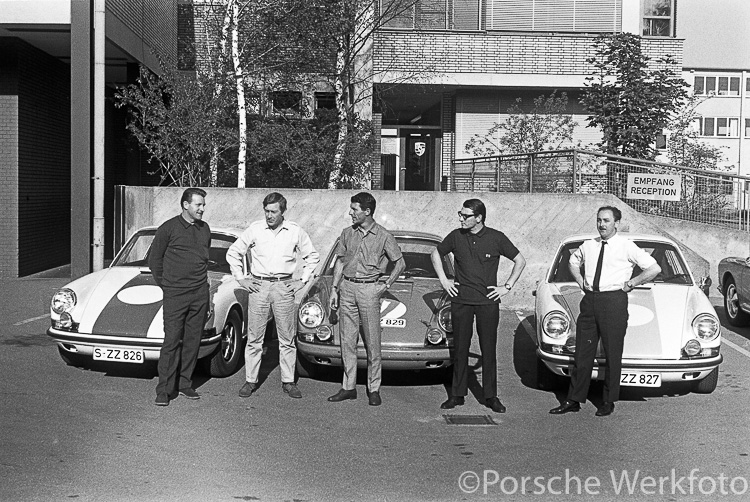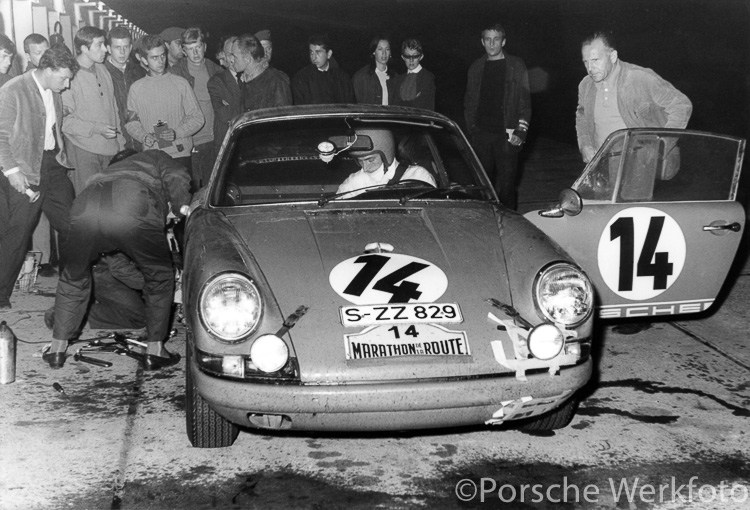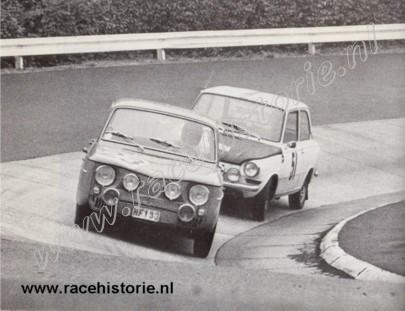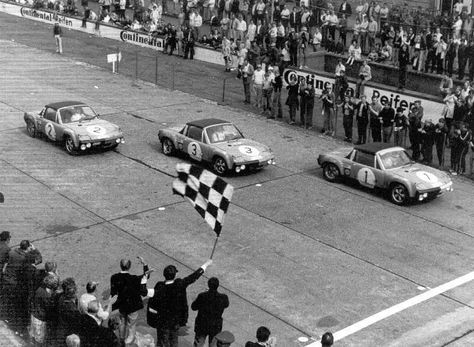This will likely be the last time I do this article, because I don’t expect to find much else to write about, and writing about flips from the 50s doesn’t really interest me much. This one will contain both NASCAR Cup and the lower series. Here we go.
1. J.T. PUTNEY (1965 ATLANTA 500: NASCAR CUP @ ATLANTA)
Arden, North Carolina’s J.T. Putney found himself going for a ride during a Grand National race at Atlanta in 1965. The #19 Latimer-Looney Chevrolet 1965 Chevy Chevelle swung right in front of leader and eventual winner Marvin Panch and was gently guided into the backstretch wall. Putney vaulted the guardrail and tumbled over a few times down the embankment. Putney suffered a broken nose but was back behind the wheel within a few days.

2. BOB TULLIUS (1969 BULLDOG 400: NASCAR GRAND TOURING @ GRESHAM)
Bob Tullius of Falls Church, Virginia holds the distinction of the only known flip in NASCAR’s old Grand Touring Division. Early in a race at what’s now Gresham Motorsports Park in 1969, Tullius received a small bump from the back, and the #94 Tullius Racing 1969 AMC Javelin flew over the turn 3 wall and went somersaulting side over side outside the speedway. Tullius was unscathed.
3. DAVID PEARSON (1970 TEST SESSION: NASCAR CUP @ TALLADEGA)
Not much is available on this one, but it comes from Forty Years of Stock Car Racing.
About a month before the 1970 Talladega 500, David Pearson and Charlie Glotzbach took part in a Goodyear tire test. During the test, Pearson’s #17 Holman-Moody Racing 1969 Ford Torino blew both right side wheels in turn 3, spun out of control, and lifted up and onto its side. The car slammed back down to earth without flipping all the way over, skidded backwards into the wall, and Pearson got out of there okay. The blowouts reportedly happened at 192mph, and Pearson was coming to finish his third lap, so clearly those tires needed some work…
4. FRED LORENZEN (1971 SOUTHERN 500: NASCAR CUP @ DARLINGTON)
This was a violent, violent crash.
During practice for the 1971 Southern 500, Fred Lorenzen lost control of the #21 Purolator 1971 Mercury Cyclone and piled into the turn four wall. According to other drivers, he had spent most of the lap attempting to save the car, as it was suffering some sort of major failure, and he just couldn’t hold it anymore. Lorenzen climbed on top of the wall, shot into the sky, and did a single barrel roll in the air before landing on its wheels. Lorenzen’s car then suffered a stuck throttle and, without slowing much, knocked a massive hole in the frontstretch wall. The hit was so hard that Lorenzen actually turned over again, lifting up onto its side and spinning around several times on its window before slamming back down. It was an absolutely horrifying crash, one of the biggest hits seen up to that point, but Lorenzen survived. He required surgery and was back behind the wheel within a few weeks.
5. DICK BOWN (1973 PORTLAND 200: NASCAR WEST @ PORTLAND)
During a 1973 West race at the Portland Speedway, city local Dick Bown, father of Jim and Chuck, spun his #02 Ober Logging 1973 Dodge Challenger into the wall in a simple crash that seemingly collected no other cars. The car lifted up and turned over twice. Bown climbed out of his car with cracked ribs, which for him was nothing too serious. This was his last full time run in the #02, as Bown, a local racing legend, failed to qualify for the season finale (the next race) and had to buy a ride.
6. JOE YOUNG (1977 UNNAMED RACE: NASCAR DASH @ ROCKINGHAM)
Not too much is known about this one, and most of the few details are lost to the hands of newspaperarchive, but the family of Richmond, Virginia’s Joe Young probably haven’t forgotten. The practice session leading into an 83-lap Baby Grand race at Rockingham was chockful of accidents, and Young found his #05 Young Racing Chevy Vega on its roof during a pileup in one of the corners. He wasn’t hurt.
7. BUTCH LINDLEY (1983 HAMPTON CHEVY 200: NASCAR XFINITY @ LANGLEY)

Early on in the Late Model Sportsman race at Langley in 1983, Tommy Ellis and Butch Lindley were dueling for the lead when Wayne Broome returned to the track from an extended time in the pits, which were on the outside. Broome swung down the track, and entering turn one, he started to drift back up. Broome collided with Ellis, Ellis collided with Lindley, and the two leaders shot up and into the outside wall in turn two. Both cars pierced the guardrail, and Lindley’s brand new #76 Loven Racing Pontiac Ventura took to the air. It went over the top of Ellis’ car, flipped twice, and came to rest on its side in the pit area, nose facing the speedway. No bystanders were injured.
Ellis climbed out of his car unhurt, and Lindley was extricated through the windshield and was taken to the hospital with minor undisclosed injuries. Wayne Broome was also taken out of the race. Despite the crash seemingly being on Broome, NASCAR ruled the incident a racing deal. According to Late Model Sportsman director Lance Childress, the marshal manning the pit exit was not allowed to prevent cars from leaving the pits under green (he could only signal that faster traffic was coming, which he did) and could only hold cars under caution.
8. MARK DAY (1987 RAINBO BREAD 200: NASCAR ALL-AM @ BRISTOL)

Clarksville, Tennessee short track ace Mark Day entered the Rainbo Bread 200, a race combining the ARTGO Challenge Series and the NASCAR Winston All-American Challenge, in 1987. The All-American Challenge was a short track series that lasted a few years in the 80s, seemingly discarded when NASCAR purchased the All-Pro Series in 1991. Day’s entry didn’t even make it to the green flag, however. The #15 Day Enterprises Chevy Camaro slammed the turn 4 wall during his qualifying run and flipped over, skidding on its roof in front of a flagman who was no doubt confused. Day climbed out of his car unhurt. He withdrew from the race.
9. JOE KOSISKI (1989 ARCA 500K: ARCA @ TALLADEGA)
Dirt late model beast and Omaha native Joe Kosiski lost control of the #53 Kosiski Auto Parts Pontiac Grand Prix early in an ARCA race at Talladega in 1989 and skidded up into the turn two wall. He slammed the barrier, flipped over, and went spinning wildly like a top down the banking. He wasn’t hurt. Red Farmer needed an examination after he crashed trying to avoid Kosiski, and second place Grand Adcox had to call it quits when he, too, hit the wall in response. This is likely the most recent flip in either the top 3 series or ARCA that there are no videos or photos.
10. JOE BUFORD (1999 TOM JOHNSON/EASYCARE 100, NASCAR DASH @ CHARLOTTE)
During the Goody’s Dash days, Gary Moore’s team was often a revolving door for drivers, and Franklin, Tennessee’s Joe Buford was no exception, entering the 1999 Charlotte race. Buford, however, only lasted three laps in his one start in the Moore Racing car. He upended the #99 Five Brothers Produce / Torbert Trucking Pontiac Sunfire after being caught up in a major pileup in the middle of a corner on lap four, ending up on his roof on the apron. He was unhurt.
Sources:
“Forty Years Of Stock Car Racing Vol. 3”, book by Greg Fielden
“Lorenzen OK After Wreck”, The News and Observer (Raleigh), Sept. 3, 1971
“Langley Drivers Want Safer Guard Rail”, Daily Press (Newport News), May 12, 1983
“Leslie captures ARCA 500-kilometer”, Morning Call (Allentown), July 30, 1989








